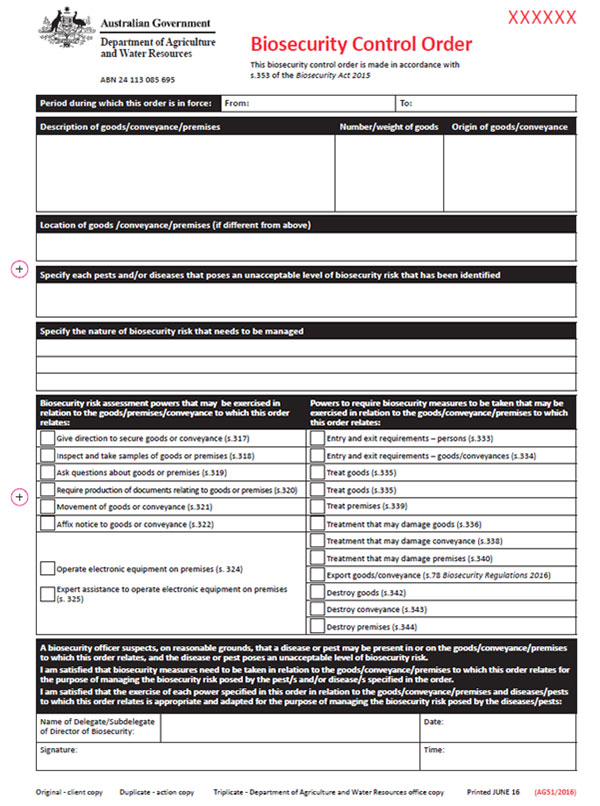28 June 2016
There are some differences in how biosecurity directions are now issued under the Biosecurity Act 2015 which came into effect on 16 June 2016.
From an importer’s perspective, not a lot has changed from the previous process of importing goods and conveyance (vessels and aircraft) arrivals. There have been changes in terminology for example the word ‘quarantine’ has, in most cases been changed to ‘biosecurity’, and we refer to vessels and aircraft arriving into Australia (under their own steam) as conveyances. There are some differences in how directions are given via the department’s electronic systems and the suite of manual paper based forms currently being used.
More information about changes to terminology under the Biosecurity Act can be found on the department’s website.
Importantly, there is also a new requirement for the person in charge of goods subject to biosecurity control to report biosecurity incidents in certain circumstances.
All goods automatically become subject to biosecurity control as they enter Australian territory from overseas. This has eliminated the need for biosecurity officers to ‘order goods into quarantine’. As a result, the ‘Order into Quarantine’ form no longer exists.
Reporting biosecurity incidents
The person in charge of goods that have not been released from biosecurity control is required to report biosecurity incidents to the Department.
It is important that biosecurity incidents are reported as soon as practicable, to ensure that any biosecurity risk associated with the incident can be managed to an acceptable level and to limit the risk associated with any pest or disease entering, establishing or spreading into Australian territory.
Biosecurity incidents are generally incidents that result in the import conditions not being able to be managed in the way that has been directed, such as a newly identified infestation, the security of the goods being compromised, or the goods being lost or stolen.
This report can be made by calling 1800 798 636 and/or by completing the Reportable Biosecurity Incident form.
The legislative instrument that details the requirements for reporting biosecurity incidents is at the Federal Register of Legislation website.
Note: Failure to report a reportable biosecurity incident as soon as practicable after becoming aware of it is an offence and may make you liable to a civil penalty.
Electronic systems and directions
Functions previously performed in the department’s electronic systems under the Quarantine Act 1908 are still performed in these systems.
Most of these systems have been updated to reference the powers and processes under the Biosecurity Act 2015.
Key systems include:
- the Agriculture Import Management System (AIMS)
- Self-Assessed Clearances (SAC).
The messaging from the ICS has been amended to reference ‘biosecurity’ in place of ‘quarantine’ in most instances. ICS messaging for the Imported Food Inspection Scheme has not changed.
As previously notified, the Vessel Monitoring System (VMS) and associated forms has not changed. This is due to the impending introduction of the Maritime Arrival Reporting System (MARS).
The use of current forms and references in VMS continues. This will reduce the impact on industry partners between the new legislation and MARS being introduced later in 2016.
AIMS directions
The following table identifies AIMS directions that have been changed to align with the Biosecurity Act 2015.
| Old AIMS Direction | Replacement AIMS Direction | ||
|---|---|---|---|
| Category | Old Direction Name | New Category | New Direction name |
| Hold | Officer Hold, contact QTNE | Secure | Contact Biosecurity |
| Insp. Wharfside for GAS | Insp. Wharfside for GAS | ||
| Pending Insect ID | Pending Insect ID | ||
| Pending Test Results | Pending Test Results | ||
| Seals Intact | Seals Intact | ||
| Fertiliser Hold - OIQ | Fertiliser | ||
| Pending documentation | Movement withheld | Pending documentation | |
| Hold – Pending Agree to Treat | Pending Agree to Treat | ||
| Pending Information | Pending Information | ||
| ICS amendment required - Qtine | ICS amendment required | ||
| Seal Intact Pending Docs | Movement allowed | Seal Intact Pending Docs | |
| Inspection | Inspect (Hold Seals Intact) | Inspection | Inspect (Secure Seals Intact) |
| Insp Live Fish @ DAFF Office | Insp Live Fish @ Dept Office | ||
| SIP- Hold Seals Intact | SIP- Secure Seals Intact | ||
| Isolation | Quarantine of Lab Animals | Isolation | Isolation of Lab Animals |
| Quarantine of Zoo Animals | Isolation of Zoo Animals | ||
| Hold Pending Qtn release | Pending biosecurity release | ||
| 7 Days Q'tine of LIVE FISH | 7 Days Isolation of LIVE FISH | ||
| 21 Days Q'tine of LIVE FISH | 21 Days Isolation of LIVE FISH | ||
| Quarantine of Horse | Isolation of Horse | ||
| Quarantine of Canine | Isolation of Canine | ||
| Movement | Canine/Dog to Vet | Movement Allowed | Canine/Dog to Vet |
| To specified premises | To specified location | ||
| To specified PEQ Facility | To specified PEQ Facility | ||
| Zoo/ Circus Animal Movement | Zoo/ Circus Animal Movement | ||
| Surveillance | Follow Up Inspection Required | Compliance Verification | Sea Cargo Survey |
| Transhipped Shipstores | Verification | Transhipped Shipstores | |
| Cargo assessment FCL | Cargo assessment FCL | ||
| Cargo assessment LCL | Cargo assessment LCL | ||
| Transhipment of Ship Stores | Surveillance | Transhipment of Ship Stores | Verification |
| Hold Seals Intact Verification | Secure Seals Intact Verification | ||
| Administration | Hold Pending Payment | Administration | Pending Payment |
| Compliance Agreement | Approved Arrangement | ||
| Referred to I&E | Referred to ENF | ||
| Documentation | CA documentary clearance | Documentation | AA documentary clearance |
| Export | Supervised by Quarantine | Export | Supervised by Biosecurity |
New Directions
| Category | Direction Name | Usage of direction |
|---|---|---|
| Movement withheld | High value approval required | Used when high value goods are being sent for treatment or destruction. |
| Disposal Permission | To Dispose of Commodity | Used to give permission for the person in charge of the goods to dispose of the goods. |
| To Dispose of partial commodity | ||
| To Dispose of non-commodity | ||
| Isolation | Isolation with conditions | These directions will be used by inspection officers. They will serve as a notice that can be affixed to good/conveyance or area that is under biosecurity control. |
| Isolation | Isolation with conditions | These directions will be used by inspection officers. They will serve as a notice that can be affixed to good/conveyance or area that is under biosecurity control. |
| Biosecurity Control | Biosecurity Control Notice | |
| Secure | Secure as directed |
Manual forms
There is a new suite of manual paper based forms including directions, notices and orders.
The new forms replace the existing manual forms and these new forms will be utilised when:
- there is limited access to the departments network/printer
- there is an electronic system outage
- undertaking wharf and depot assessments and surveillance activities
- post border detections.
Examples of the new electronic and manual forms follow:
Att 1 – Conveyance subject to biosecurity control assessment and management
Att 2 – Goods subject to biosecurity control assessment and management
Att 3 – Isolation notice
Att 4 - Exposed goods order
Att 5 - Biosecurity control order
Further information
There are now additional pieces of communication material, specifically focusing on what is changing for industry members.
This information is available on our website at the links provided below.
- Importers
- Quarantine Approved Premises and Compliance Agreements
- Installations and petroleum industry
- Shipping industry
- Airports airlines and aircraft operators
Industry groups are invited to share this information with members and any other interested parties.
For more information, please visit The Biosecurity Act 2015 or contact the Biosecurity Implementation Branch at New Biosecurity Legislation or call 1800 040 629.
[expand all]
Attachment 1: Conveyance subject to biosecurity control assessment and management
The following attachment is a sample of the conveyance subject to biosecurity control assessment and management form. This will be used to manage aircraft and vessels.
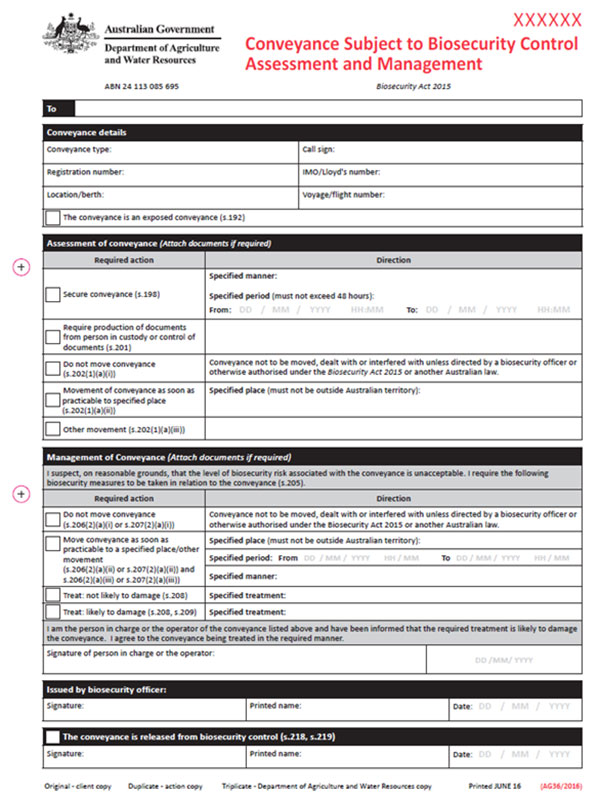
Attachment 2: Goods subject to biosecurity control assessment and management
The following attachment is a sample of the goods subject to biosecurity control assessment and management form. This would be commonly used on the wharf and or a depots.
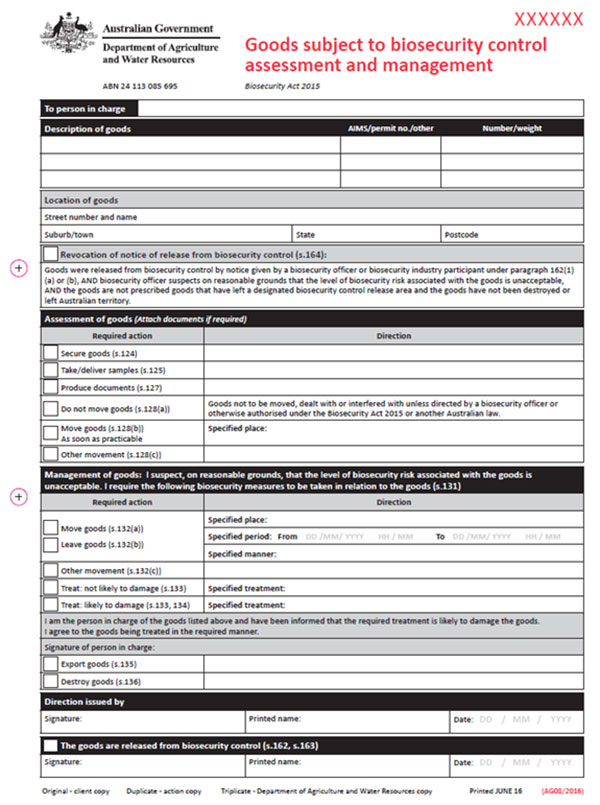
Attachment 3: Isolation notice
The following attachment is a sample of an isolation notice. This would be commonly used in the clearance of some live animals and plants.
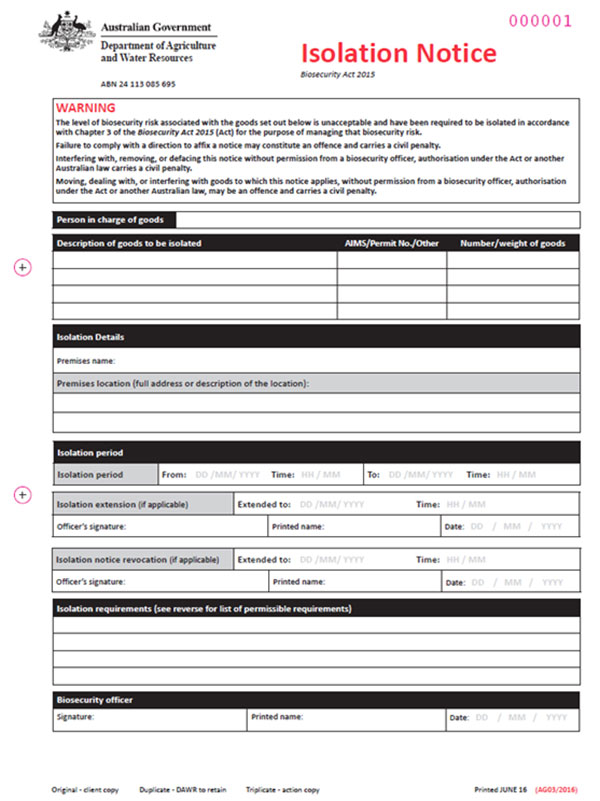
Attachment 4: Exposed goods order
The following attachment is a sample of the exposed goods order. This will be commonly used at the wharf and depots.
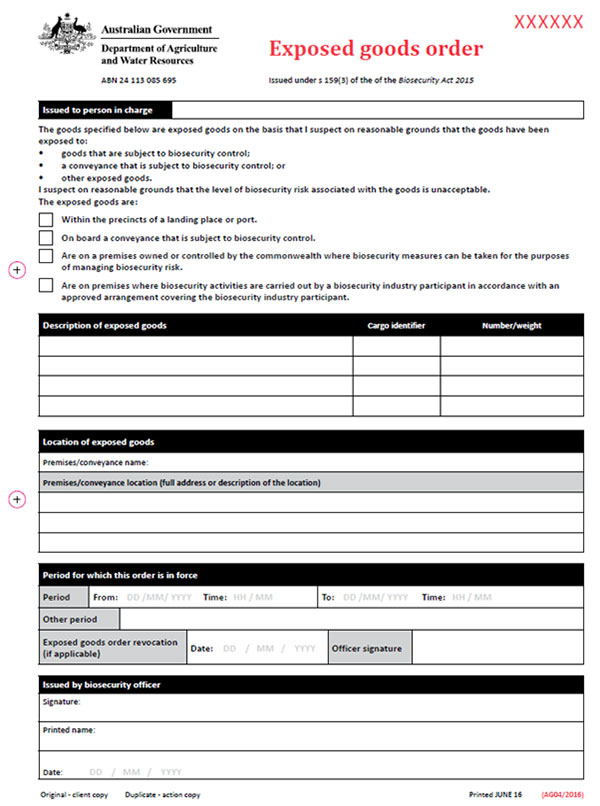
Attachment 5: Biosecurity control order
The following attachment is a sample of the biosecurity control order and will be commonly used during surveillance.
